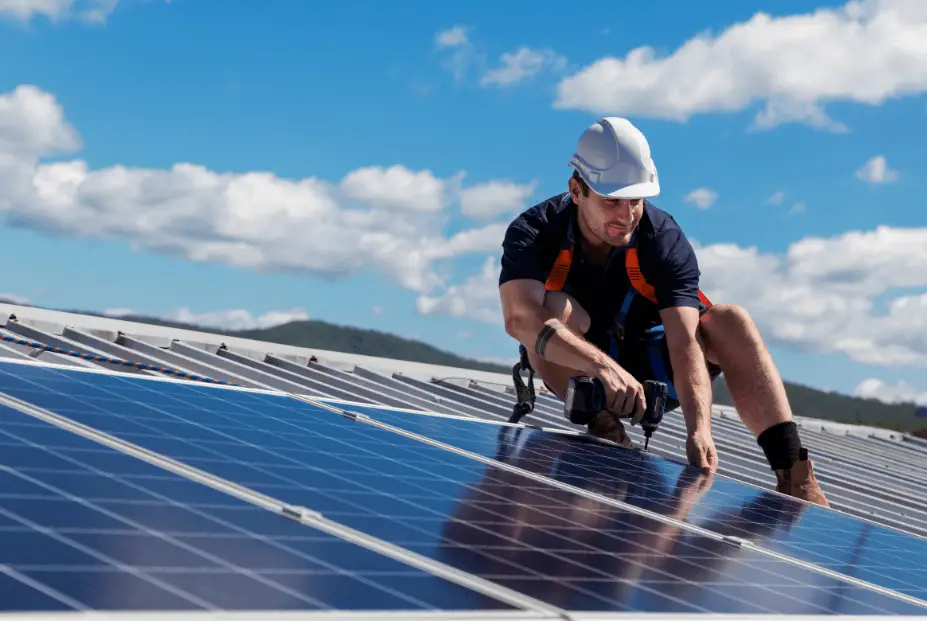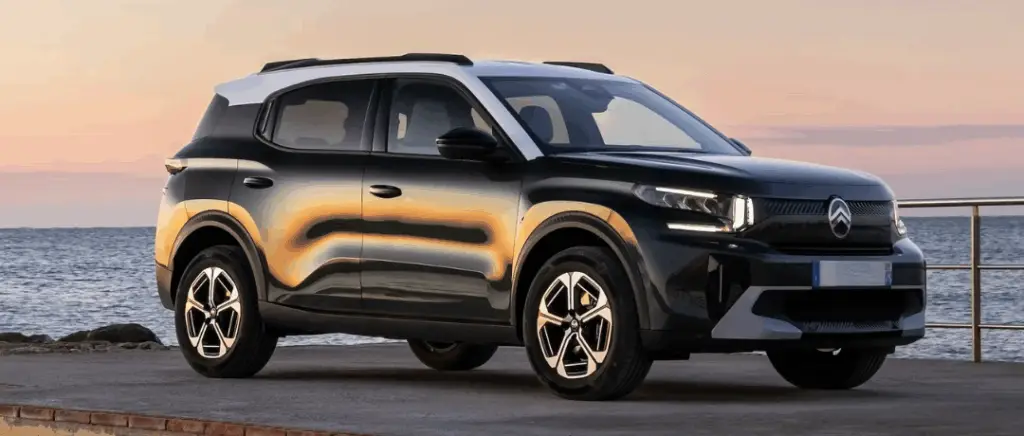How can companies use solar panels to power electric vehicles?
Solar panels, also known as photovoltaic panelsThese panels convert sunlight into electricity. In practical terms, each panel is made up of silicon cells that react to the sun's rays to produce an electric current. Their production capacity is measured in kilowatt-peak (kWp)a unit that indicates the maximum power generated under ideal conditions.
Depending on the amount of sunlight, a square metre of panel can produce between 200 and 350 watts of electricity. This energy can be used to cover part of a building's electricity needs, stored or fed back into the grid.
Perhaps you've already integrated solar energy into your business to reduce your electricity bills for lighting or heating? Solar energy can also be used to power your fleet of electric vehicles.
Installing solar panels in your car parks gives you the opportunity to produce your own electricity and send it to your recharging points. Of course, this means deploying the right infrastructure (panels, inverter, charging points). But once it's in place, it will enable you to control your energy consumption from A to Z. The result: greener recharging and less dependence on the traditional network!
What are the advantages of energy storage for recharging electric vehicles in the workplace?
Installing photovoltaic panels in your company to recharge your fleet of electric vehicles can become a real challenge. strategic lever to reduce your costs and facilitate your energy transition.
Economic benefits
Even though the initial investment may seem substantial, the solar panels to recharge your vehicles can significantly improve the TCO (Total Cost of Ownership) of your fleets. Imagine being able to reduce your fleet recharging costs to virtually zero? By promotingself-consumptionIn the long term, you can achieve almost complete independence from the conventional grid.
Ecological benefits
Powering vehicles with renewable energy from your own facilities reduces the amount of energy used by the vehicle.carbon footprint of your company. In this way, you are providing a concrete response to environmental and regulatory issues. Don't lose sight of the fact that the public authorities are aiming for carbon neutrality by 2050 and impose strict obligations on companies in terms of decarbonisation.
It's also a strategy that's part of strengthening your CSR and helps to improve your brand image in the eyes of customers, investors and partners.

How can self-consumption of energy for electric vehicles be optimised?
L'self-consumption consists of directly using the solar energy produced by your photovoltaic installation for your internal needs, in this case to charge your electric vehicles. Surplus energy can then be sold back to the grid via specific contracts, such as thePurchase obligation (OA).
Use these tips to optimise the self-consumption of electricity from your company's electric vehicles:
1. Synchronise recharging naturally with solar production
Even without sophisticated equipment, you can already optimise recharging sessions by synchronising them with solar production. All you have to do is programme them when the sun is shining, so that you can consume the electricity produced by your panels directly.
This strategy is particularly suitable if your vehicles are parked during the day and your employees work on your premises. However, it has its limitations for a fleet of electric vehicles dedicated to daytime travel.
2. Monitor your panel production with an intelligent tool
Install a supervision of your photovoltaic installation can help you improve its yield. These tools allow you to monitor the output of your panels hour by hour and to see the impact of the weather or other factors on the energy generated.
Supervision solutions often offer additional functions: performance and profitability monitoring, fault detection and remote assistance. They generally consist of a data logger connected to the inverters via a converter, and display the information on a web interface or secure personal space.
Thanks to this data, you can identify precisely the best times to charge your electric vehicles. In this way, you can reduce your electricity consumption on the conventional grid, and take a further step towards green energy. autonomous energy production.
3. Install an intelligent charging point
To take things a step further, some photovoltaic charging stations are capable of automatically synchronising charging with solar production. These systems are based on several elements:
- a intelligent charging point ;
- a photovoltaic production measurement module ;
- sometimes an additional module if the solar production is spread over several appliances;
- the cables needed to connect the various modules.
Good to know: it is essential to call on the services of a IRVE certified installer trained in communicating charging points.
With Beev
Switch to
Electric cars
or install your
Charging station
For individuals and businesses
What strategies can be used to reduce the energy costs associated with electric vehicles?
Optimising the energy consumption of your electric fleet is an important way of reducing the carbon footprint of your business. TCO and improve your overall performance.
Reduce the frequency of recharging
Reducing recharging cycles to a minimum reduces wear and tear on batteries and cuts energy consumption. A good practice is to recharge vehicles between 20 % and 80 %This will extend the life of the batteries and save money in the long term.
Adapting vehicle driving
Encouraging smoother driving (gradual acceleration, anticipating braking, limiting excessive speeds) helps to reduce energy consumption and, by the same token, the cost of recharging. This approach also helps to extend theautonomy vehicles.
How can you limit peak consumption while recharging electric vehicles?
Reloading at the right time
For a company, recharging its fleet of electric vehicles without generating additional costs or peaks in consumption is essential. There are several strategies for optimising charging while respecting the constraints of the network and the company.
Smart charging involves programming charging to take place at the most advantageous times. In practical terms, this means
- During off-peak hours, when the price of kWh is lowest ;
- When your solar panels are producing energy, you can use the solar-generated electricity directly;
- When the production of green electricity is high at national level, to support the energy transition.
This simple approach reduces costs and allows you to recharge more responsibly.
Distributing the load intelligently
Le load balancingor charge sharing, consists of distributing the available power between several charging vehicles. This avoids overloading the network and optimises the overall performance of the charging points. It is particularly useful in company car parks, where several vehicles need to recharge simultaneously.
Using electric vehicles as an energy reservoir
Le Vehicle-to-Grid (V2G) is a technology that turns your electric vehicles into mobile batteries. During peaks in demand on the grid, the cars can send electricity back, helping to stabilise the grid and maximise the use of stored energy.
Rely on these technical advances to recharge your fleet efficiently, while controlling costs and making full use of renewable energy.
What solutions combine solar panels, batteries and IRVE for electric vehicles?
Recharging an electric vehicle using solar energy requires a suitable infrastructure. The first step is to combine photovoltaic panels at charging stations connected to your electrical system. This system allows you to recharge your vehicles with electricity generated on site or, if necessary, with electricity from the grid. Visit photovoltaic shadinginstalled directly on your car parks, are a practical alternative for capturing solar energy while protecting your vehicles.
However, solar production is by nature discontinuous and varies according to the seasons and weather conditions. To compensate for this variability, it is essential to deploy systems to store energyThese systems, such as batteries, enable surplus electricity to be stored for later use, particularly during peak consumption periods.
Good to know: an installation that complies with regulations.
La renewable energies acceleration act (ApER law), adopted on 10 March 2023, now requires the installation of solar panels or photovoltaic shades on certain infrastructures, including large-scale car parks.
For car parks larger than 1,500 m², solar panels are a legal requirement, representing at least 50 % of the total surface area. Since July 2025, a mix of trees and panels has been possible, provided that at least 35 % of the car park is covered by solar panels if 50 % of the surface is planted with trees.
Implementation times vary according to the size of the car park:
- Car parks of more than 10,000 m² have until 1 July 2026 to comply with the law;
- the other car parks have a further two years, until 2028.
Source : Légifrance
What indicators should be tracked to measure the energy efficiency of electric vehicles in the company?
Monitoring key indicators is essential for effectively managing a company's electricity transition. vehicle fleet. It provides fleet managers with a clear view of the operational, financial and environmental performance of electric vehicles, while facilitating the production of extra-financial reports.
Installing solar panels can have an impact on all of the following KPI used to measure energy efficiency, improving the overall performance of your electric fleets:
| Indicator | Definition / Measurement | Potential impact of solar panels |
|---|---|---|
| TCO (Total Cost of Ownership) | Total cost including purchase, energy, maintenance, insurance and depreciation | Reduced energy costs thanks to self-generation of electricity, lower overall TCO |
| Energy cost per km | Cost of energy consumed to cover 1 km | Optimisation of cost per km, as solar electricity is cheaper than grid electricity |
| CO₂ emissions avoided | Reduced emissions compared to combustion vehicles (WLTP standard) | Solar recharging reduces fossil fuel use and increases the CO₂ avoided |
| Operational monitoring and ESG reporting | Centralisation of data for audits, CSR and extra-financial reports | Solar data can be used to enhance environmental performance and strengthen ESG KPIs |
Adopt a strategy combining solar panels, batteries and IRVE to recharge your electric vehicles represents a powerful lever for reducing costs, securing your energy supply and improving your carbon footprint.
By synchronising recharging with solar production, using smart charging points and storing excess energy, your business can make the most of its photovoltaic installation, while meeting increasingly stringent regulatory requirements.
This approach is not limited to the economic dimension: it is part of a global vision of social and environmental responsibility. Tracking key indicators allows you to assess the benefits in concrete terms and adjust your strategies over time.
You're ready to take on tomorrow's energy and environmental challenges ? By combining IRVE, solar panels and battery storageYou can take advantage of the most advanced technologies and transform your business into a veritable energy hub !
You would like toto electric?
Beev offers multi-brand 100% electric vehicles at the best prices, as well as recharging solutions.
































